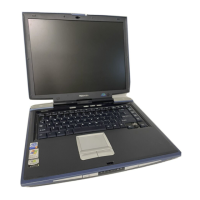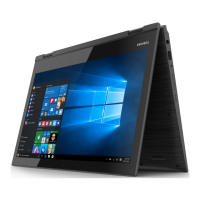
Do you have a question about the Toshiba Satellite 1805 Series and is the answer not in the manual?
| RAM | 128 MB |
|---|---|
| Storage | 20 GB HDD |
| Display Size | 15.0 inches |
| Display Resolution | 1024 x 768 pixels |
| Optical Drive | DVD-ROM |
| Operating System | Windows XP |
| Battery | Lithium Ion |
| Ports | Parallel, Serial, VGA, RJ-45 |
| Wireless | Optional Wi-Fi 802.11b |
Contact methods for technical help including e-support and phone center.
FCC/IC compliance, critical application disclaimers, and RF exposure warnings.
Guides for modem installation, usage, and problem resolution.
Details on wireless features, network connectivity, and internet access.
Safety guidelines for optical drives, copyright, and export regulations.
Verify all computer components and accessories are present before proceeding.
Locating and identifying major physical parts and ports of the computer.
Details on front panel controls, status lights, and underside features.
Guidance on workspace selection, posture, lighting, and comfort.
Essential setup steps, safety measures, and component connections.
Connecting power, charging battery, installing peripherals, and software setup.
Computer maintenance, turning off, and security measures.
Essential computing tips, keyboard usage, and launching applications.
Saving work, file operations, and using floppy diskettes.
Using CD/DVD drives, caring for discs, and setting up communications.
Connecting to networks, modems, and establishing internet access.
Introduction to the Windows XP desktop, icons, touchpad, and basic tasks.
Navigating the internet and creating new files and folders.
Starting, closing, resizing, and organizing windows and programs.
Creating shortcuts, managing desktop objects, and using System Restore.
Customizing the desktop appearance and folder browsing settings.
Connecting to LANs, wireless networks, and the internet.
Transferring files, using the internet, and managing online connections.
Creating custom keyboard shortcuts for programs and documents.
Tool for configuring hardware settings and device options.
Managing power settings to optimize battery life and performance.
Instructions for playing DVDs and using the WinDVD multimedia center.
Using the toolbar, status bar, control panel, and customizing playback settings.
Identifying and resolving issues with programs, startup, and general system operation.
Diagnosing and resolving hardware conflicts, driver issues, and peripheral problems.
Troubleshooting problems with disk drives, sound systems, and PC Cards.
Diagnosing and resolving problems related to power, keyboard, display, and modem.












